Profile: Naomi Halas
- Posted 04.19.05
- NOVA scienceNOW
(This video is no longer available for streaming.) Nanotechnologist Naomi Halas of Rice University has invented tiny structures called "gold nanoshells," which may someday help treat tumors. Halas tunes the nanoparticles to absorb a specific wavelength of light that passes harmlessly through the human body. When that light hits the injested nanoshells, they grow hot enough to burn away targeted nearby tissue such as a tumor.
Transcript
PROFILE: NAOMI HALAS
PBS Airdate: April 19, 2005
ROBERT KRULWICH: Okay, enough of big, time to get small again. And I mean really, really small. Here's something exquisitely small. This is the tip of a pin. We're going to move in on the tip and get smaller still.
You see those little blobs there? They are bacteria on the pin, and then on the bacteria, you see that little speck? It's a few hundred atoms across.
That teeny thing made news recently, because it is an invention. It was built by a scientist you're about to meet. And the fact that she is a she was also news, because there aren't a lot of shes doing this kind of thing. And some prominent folks have wondered why. So here is her story.
Naomi Halas knows how guys think. Her ranch in Texas is way, way outside Houston in brush country, so it's a little hard to find, but, as it happens...
NAOMI HALAS: One of our neighbors used to be a, was a former Penthouse Pet, so she was a bit of a local celebrity.
ROBERT KRULWICH: So whenever Naomi needed lumber, or whatever, delivered, all she had to say to the delivery guy, any delivery guy apparently, was...
NAOMI HALAS: "Do you know where the stripper lives?" And they would all know. And so rather than going into long detailed directions, all I'd have to do is say well, we're about 200 yards past the stripper, on the left.
ROBERT KRULWICH: The ranch is for weekends. During the week, Naomi Halas is a professor at Rice University teaching Nanotechnology and Applied Physics, fields that are 90 percent dominated by men. But not here. Not in her group. If you look around, it's about even, which is different for guys...
SWEDISH GRAD STUDENT: I think this is great. What else could I say?
ROBERT KRULWICH: ...and very different for women.
STUDENT: Being a woman has actually never been an issue for me in this group. You just forget about it, which is nice, a nice feeling, because a lot of people aren't that lucky.
ROBERT KRULWICH: So how'd this happen? How'd Naomi create such an unusual balance? Even her husband—this is Peter—he joins the group, not as the leader, he's just one of the gang. Well, there's a story here.
NAOMI HALAS: You know, the best science stories are told backwards, okay? So...
ROBERT KRULWICH: So let's go back a bit. When Naomi was growing up—yeah that's her, and so is this—she never thought about becoming a scientist, even in high school.
NAOMI HALAS: I remember very clearly in high school, although I was always at the top of my class in math and science, I was told, "Don't take physics." And the reason I was told not to take physics was because if I ever took physics, I would never get a date.
ROBERT KRULWICH: So she didn't take physics, she became a musician. And one day, she was wondering where sounds came from, and a friend said, "Well, acoustics requires calculus."
NAOMI HALAS: "But, of course, you've taken calculus, haven't you?" And it just kind of hit me like a load of bricks. In fact, I hadn't taken calculus. I had actually bought into this myth that maybe I probably wasn't going to be very good at math.
ROBERT KRULWICH: But she was good. So at 20, she decided, "You know what? I'm going to drop music and switch to something science-y."
NAOMI HALAS: I thought, "Well, maybe I want to retool my career."
ROBERT KRULWICH: But what about her, you know, her uh, feminine problem?
NAOMI HALAS: No, I didn't, I didn't have a feminine problem.
ROBERT KRULWICH: In other words, you weren't embarrassed to do un-girlish stuff?
NAOMI HALAS: No, I was really a...I was really butch, actually.
ROBERT KRULWICH: So she switched from music to chemistry, and then, interestingly, chose a female-friendly graduate program at Bryn Mawr.
NAOMI HALAS: Bryn Mawr was certainly a place where women were 100 percent accepted.
ROBERT KRULWICH: And that's where she got her M.A. and Ph.D. in physics, and she married.
NAOMI HALAS: Have you thought about doing that?
ROBERT KRULWICH: And when she joined the faculty at Rice University, Naomi found herself increasingly attracted by the world of the very, very small, the nano world.
NAOMI HALAS: This is a vial of gold nano particles, solid gold nanospheres.
ROBERT KRULWICH: They're so small you can't see them. They're little clumps of gold atoms. But if you invent a clump that's hollow inside it will absorb a different color of light. And by changing the thickness of the gold shell, you can make it absorb whatever color you want. So look. Here, what was once ruby red is now clear.
Naomi's work was new and very interesting to graduate students, well to men. Women...?
NAOMI HALAS: For the first six years, I had no women whatsoever. And then I had one. And once, once I had her, I became okay, and then lots of women began to join my group.
ROBERT KRULWICH: Which was, at first, kind of unusual.
GRADUATE STUDENT: We're changing that. It won't be unusual for long.
ROBERT KRULWICH: Women told women, "This is a good group." Naomi says, "You know, I never planned this."
NAOMI HALAS: It just seems to sort of happen. Maybe having all these women attracts the men.
ROBERT KRULWICH: So in the end, she gets a balance. But the growing gang of women at Rice were at first, invisible.
NAOMI HALAS: For most of my scientific career I didn't publish with my first name in the paper. I was always N. Halas. And so, many people knew about my work and had no idea I was a woman, because they read my work in the literature.
ROBERT KRULWICH: But when Naomi and her colleagues created nanoshells by manipulating atoms, then the world noticed: The New York Times, Popular Science, Profiles. Nanoshells made Naomi and her lab famous. And yet, even as a tenured professor, plus by now she'd bought the ranch. As successful as she was, one day when she was presenting her findings at a meeting at Rice...
NAOMI HALAS: A man walked up to me, and in a very loud voice, said, "Excuse me, are you the lady in charge of the coffee?" And when I heard that, I just turned around and I walked back to my office, and I just sat there and, you know, I almost burst into tears. This is ridiculous. I don't want to have...Is it for the rest of my life, I'm going to be mistaken for somebody who's in charge of the coffee? And then I said, "No, I think I will go back there because I don't want that person to win. I want to, I want to be, I want to participate in the forum and I don't care if he thinks I'm in charge of the coffee." So I went back.
ROBERT KRULWICH: And the contacts she made at that meeting led to a business, which she started with biology professor Jennifer West. And they are now injecting nanoshells into animals with cancer. So here, to demonstrate, they're using a chicken breast. The nanoshells will gather inside the tumor.
NAOMI HALAS: And once they're in place, then light is shined through the skin and down into the tumor site.
ROBERT KRULWICH: ...warming up the nanoshells so they burn the tumor. That's the steam there.
NAOMI HALAS: And that's sufficient to kill the cells in the tumor.
ROBERT KRULWICH: So without radiation, with light, you can attack cancer sites.
NAOMI HALAS: That's incredibly non-invasive, if you consider other types of cancer therapies.
ROBERT KRULWICH: These therapies are still being tested by the women and the men who have gathered around Naomi. But the women, she says, even now, have to struggle to stay in the game.
NAOMI HALAS: I always thought it was a generational thing. I always thought, well when I was a young scientist, "Oh, those are the older people. They're like that. But when people, when I'm older, then people won't be like that anymore." But they are.
ROBERT KRULWICH: Too often, female grad students drop out, lose confidence, struggle to balance children and family. Naomi, I noticed, does not have children, which made me wonder if that's about work.
NAOMI HALAS: No, I cannot have children.
ROBERT KRULWICH: Oh.
NAOMI HALAS: So it's not that we didn't try. I am absolutely...I mean, that's another thing that people do sometimes, look at someone who is childless and say, "Well, you know, she...you know, you like science more than, you know, children and flowers and, you know, things like that," you know? But no, I like kids too.
ROBERT KRULWICH: But what she doesn't like is that half the kids, all the girls, still have trouble making the life that she has made. That struggle isn't over.
Credits
Naomi Halas
- Edited by
- Stephen Mack
- Produced and Directed by
- Gary Glassman
NOVA scienceNOW
- Executive Producer
- Samuel Fine
- Executive Editor
- Robert Krulwich
- Senior Series Producer
- Vincent Liota
- Supervising Producer
- Andrea Cross
- Development Producer
- Kyla Dunn
- Associate Producer
- Win Rosenfeld
- Program Editor
- David Small
- Unit Manager
- Candace White
- Researcher
- Jason Spingarn-Koff
- Production Secretary
- Hong Jung
- Music
- Rob Morsberger
- NOVA scienceNOW Series Animation
- Edgeworx
- Associate Producers
- Anthony Manupelli
Mary Robertson
Cass Sapir
Ben Sweeney - Camera
- Nate Clapp
Brian Dowley
Allen Facemire
Ken Fuhr
Bob Hanna
Jack Rayzor
Jon Tichota
Joe Vitagliano
Brett Wiley
Ken Willanger - Sound Recordists
- Bob Bryan
Walter James
Anthony Rowland
Jayme Roy
George Schafnacker
Jimmy Williams
Andrew Yuncza - Audio Mix
- John Jenkins
- Animation
- Pie Design
- Additional Production by
- Simon Nasht
Annamaria Talas - Additional Music
- Mark De Gli Antoni
- Production Assistant
- Robbie Gemmel
- Compositing
- Yunsik Noh
- Special Thanks
- American Museum of Natural History
Jade Boyd
Florida State University
R. Thomas Hammond
Ann Kiessling
David Scadden - Special thanks for its decade of support for NOVA to the
- Park Foundation
- Howard Hughes Medical Institute Investigators
- Doug Melton
Leonard Zon - Archival Material
- ABCNEWS VideoSource
Rainer Albiez
Avalanche, Inc.
BBC Motion Gallery
Dr. Tony Brain & David Parker / Photo Researchers, Inc
Corbis Corporation
The Field Museum of Chicago
Gillian Darling
Susan A. Levine Photographic Art
Lubbock Metro
National Geographic Film Library
Dr. Yorgus Nikas/Photo Researchers Inc.
Bill Nipper
Paprikaas Animation Studios - Les Films D'ici, France
Popular Science
Small Times Media
Ultimate Ungulate Images - NOVA Series Graphics
- yU + co.
- NOVA Theme MUSIC
- Walter
Werzowa
John Luker
Musikvergnuegen, Inc. - Additional NOVA Theme Music
- Ray Loring
- Post Production Online Editor
- Spencer Gentry
- Closed Captioning
- The Caption Center
- NOVA Administrator
- Dara Bourne
- Publicity
- Jonathan
Renes
Diane Buxton
Olivia Wong - Senior Researcher
- Barbara Moran
- Production Coordinator
- Linda Callahan
- Unit Manager
- Lola Norman-Salako
- Legal Counsel
- Susan Rosen Shishko
- Post Production Assistant
- Patrick Carey
- Associate Producer, Post Production
- Nathan Gunner
- Post Production Supervisor
- Regina O'Toole
- Post Production Editor
- Rebecca Nieto
- Post Production Manager
- Maureen Barden Lynch
- Supervising Producer
- Stephen Sweigart
- Producer, Special Projects
- Susanne Simpson
- Coordinating Producer
- Laurie Cahalane
- Senior Science Editor
- Evan Hadingham
- Senior Series Producer
- Melanie Wallace
- Managing Director
- Alan Ritsko
- Senior Executive Producer
- Paula S. Apsell
NOVA scienceNOW is a trademark of the WGBH Educational Foundation
This material is based upon work supported by the National Science Foundation under Grant No. 0229297. Any opinions, findings, and conclusions or recommendations expressed in this material are those of the author(s) and do not necessarily reflect the views of the National Science Foundation.
© 2005 WGBH Educational Foundation
All rights reserved
- Image credit: (Naomi Halas) © WGBH/NOVA
Related Links
-
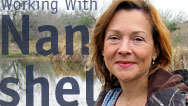
Meet Naomi Halas
The inventor of nanoshells, tiny spheres with great medical potential, discusses her lab's groundbreaking work.
-
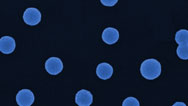
Working With Nanoshells
In this interview, nanotechnologist Naomi Halas talks in depth about her work with tiny spheres that hold great promise.
-
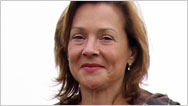
Naomi Halas: Expert Q&A
Rice University's Naomi Halas answers questions about her nanotechnology work and her career in science.
-
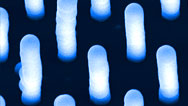
Cancer Nanotech
Structures smaller than a single red blood cell could revolutionize cancer diagnosis and treatment.
-
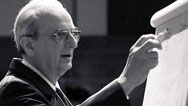
Profile: Judah Folkman
Once scorned for his ideas about how cancer grows through angiogenesis, Judah Folkman is now hailed as a visionary.



